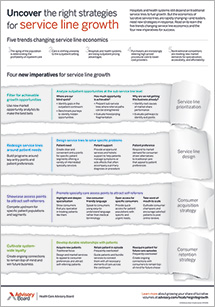Auto logout in seconds.
Continue LogoutBy Jackie Kimmell, Senior Analyst
Today's health care market is demanding new strategies for service line growth. While hospital leaders could traditionally look at market growth projections and service line financials to choose which services to prioritize, this simple approach is no longer sufficient. Rather, the new challenges in the market today require new approaches.
Inpatient care is becoming less profitable. While inpatient volumes are expected to grow by 6% by 2027, much of the growth will be concentrated among the Medicare population. Indeed, while inpatient volumes for those 65 and older are expected to grow by 24.7% in this timeframe, they're expected to contract by 3.7% among those under 65. And, since reimbursement for the Medicare population is lower than for commercially insured patients, the impact on total revenue will be significant.
On top of that, a greater proportion of high-revenue inpatient services are disappearing as more services shift outpatient because of technological advancements and payer pressures. For example, an Advisory Board analysis shows that a large hospital with 750 beds in the Midwest can expect to lose $1.05 million a year from the shift of just one service—total knee arthroplasty—to the outpatient setting.
With the growth of ASCs, new outpatient coverage decisions from CMS, and site-neutral payment reimbursement cuts, it is clear that traditional business models are at stake.
We'll be covering four key strategies to overcome these challenges in a webconference tomorrow, May 23rd at 1 PM ET. Register now to learn more, then read on to understand the three key questions you should ask to identify achievable service line growth opportunities.
3 ways to discover your top achievable growth opportunities
To make the best bets for achieving growth in this new landscape, leaders must be smart about prioritization. We see two common mistakes. First, since traditional growth opportunity formulas are usually conducted at the service line-level, leaders often miss out on procedure-level opportunities within an otherwise "unfavorable" service line. Second, leaders are often too focused on only high-revenue inpatient services—and thus miss out on potential opportunities to prioritize the outpatient services that could drive downstream growth.
For better prioritization, leaders should take a more holistic approach to identifying growth opportunities. Here are three questions they should ask themselves:
- Where are our blind spots?
To move away from an inpatient-only focus on growth, leaders should seek to understand their system's entire outpatient care continuum—and where they may have blind spots. For instance, are there certain outpatient sub-service lines where your system has lower-than-expected market share when compared to inpatient market share? This may indicate a blind spot where the system has under-invested in services. This doesn't mean that your system necessarily has to invest in building share in these services, but knowing where these blind spots lie can help craft a smart strategy for outpatient investment.
You should also consider mapping a typical journey through the care continuum to understand each of the sub-service lines that a patient would interact with and how your system competes in these services. Benchmark how many patients make it from an initial appointment through the entire care pathway—and see how this compares to other providers in the market. You may find that patients are leaving your system at a critical point in their journeys.
- How much opportunity is achievable?
Once you understand where possible opportunities may lie, you have to evaluate how likely it is that you can win business. In other words, how likely is it that your efforts to invest and compete in a particular service will pay off?
To access these opportunities, we suggest thinking about how "persuadable" the referral pathways are for each sub-service line. A PCP splitter analysis, which looks at the amount of business that PCPs in the market send to your system, can help determine how much room you truly have to win market share. Going after a sub-service line where many PCPs are already loyal to other systems may not be the best allocation of resources. Instead, you likely have a better chance to build a relationship with and win referrals from partially aligned PCPs—those who split their referrals between multiple systems.
- Why are we not getting this business already?
Once you know where your blind spots lie and which opportunities are realistic, it's worth taking a step back to ask: Is there another reason we're not getting the business we'd expect in these services already? Perhaps there's a critical technology your system is missing, long wait times causing access problems, physician referral leakage, or lack of navigation programs that would keep patients on track with treatment.
For instance, when UnityPoint Health, a health system in Iowa, Illinois, and Wisconsin, found that 80% of neurosurgery volumes were leaving their network, they realized the problem likely lay upstream with a lack of access to neurology services. In response, they hired two additional neurologists, invested in tele-neurology in the ED, and created stronger partnerships between the neurology and neurosurgery service lines. As a result, they saw that many more patients were staying in the system for care—and neurosurgery volumes increased accordingly.
Asking these three questions is key to making sure that you're prioritizing the best and most achievable opportunities for service line growth. Register now for our webconference tomorrow where we'll guide you step-by-step through these questions and explain more about the best strategy for service line planning today.
In the meantime, be sure to also download our new infographic on how to uncover the right strategies for service line growth in which we outline why the economics of service lines are changing and four imperatives you should use to respond.
Don't miss out on the latest Advisory Board insights
Create your free account to access 1 resource, including the latest research and webinars.
Want access without creating an account?
You have 1 free members-only resource remaining this month.
1 free members-only resources remaining
1 free members-only resources remaining
You've reached your limit of free insights
Become a member to access all of Advisory Board's resources, events, and experts
Never miss out on the latest innovative health care content tailored to you.
Benefits include:
You've reached your limit of free insights
Become a member to access all of Advisory Board's resources, events, and experts
Never miss out on the latest innovative health care content tailored to you.
Benefits include:
This content is available through your Curated Research partnership with Advisory Board. Click on ‘view this resource’ to read the full piece
Email ask@advisory.com to learn more
Click on ‘Become a Member’ to learn about the benefits of a Full-Access partnership with Advisory Board
Never miss out on the latest innovative health care content tailored to you.
Benefits Include:
This is for members only. Learn more.
Click on ‘Become a Member’ to learn about the benefits of a Full-Access partnership with Advisory Board
Never miss out on the latest innovative health care content tailored to you.


